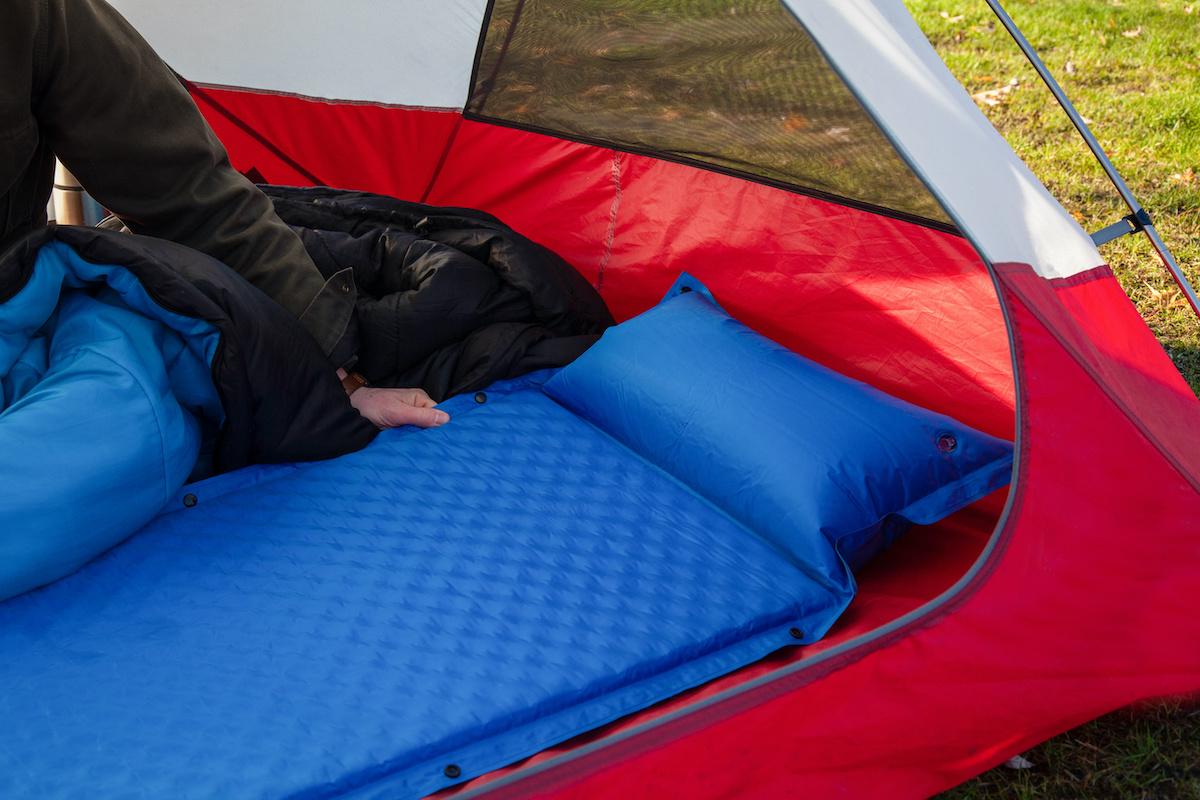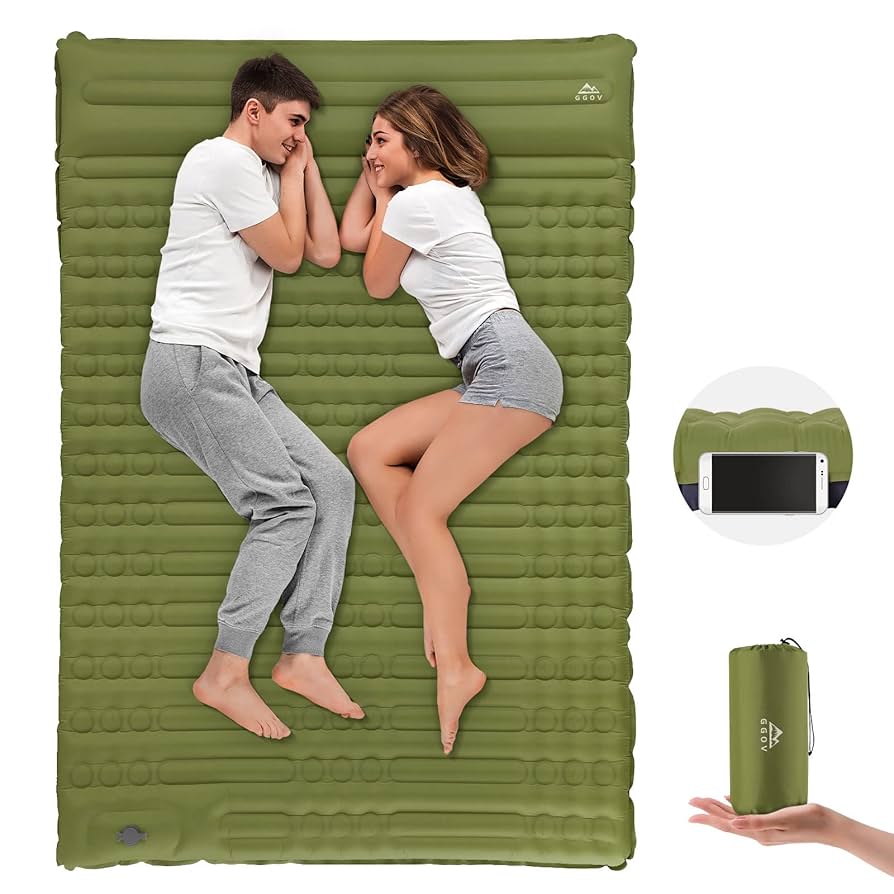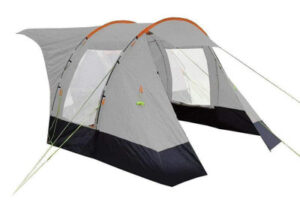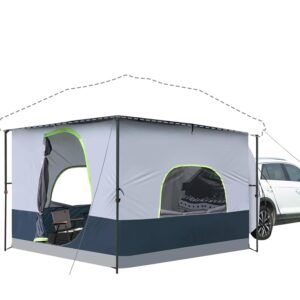Choosing between an air mattress and a sleeping pad for your tent camping adventure can be a tough decision. You want comfort, but you also need to consider space, weight, and convenience.
Imagine a night under the stars, where each breath of fresh air is invigorating, and nature’s melody soothes your soul. However, the wrong sleeping gear can turn this dream into a restless night. By understanding the differences between an air mattress and a sleeping pad, you can make an informed choice that ensures your comfort and enhances your camping experience.
Dive deeper to discover which option aligns perfectly with your camping style and needs.
Air Mattress Benefits
When planning a tent camping trip, choosing between an air mattress and a sleeping pad can impact your outdoor experience. Both have unique benefits, but air mattresses often stand out for their comfort and ease of use. Understanding the benefits of air mattresses helps campers make informed decisions for a restful night’s sleep in the wild.
Comfort Level
Air mattresses offer a superior comfort levelcompared to sleeping pads. The adjustable firmness allows you to create a bed-like feel, enhancing your camping experience. The thickness of an air mattress can vary, providing better support for your body, especially if you are sleeping on uneven ground. This feature is beneficial for side sleepers who require extra cushioning for their hips and shoulders.
- Customizable firmness
- Greater thickness and support
- Suitable for side sleepers
In a comfort comparison, air mattresses often win due to their plush surface and ability to mimic the feel of a home mattress. They are ideal for tent camping, especially for families or those who prioritize comfort. While sleeping pads are lightweight and portable, they cannot match the comfort level of an air mattress.
Insulation Properties
Air mattresses provide decent insulation properties, though they may not excel in insulation effectivenesslike some high-end sleeping pads. The air inside the mattress can sometimes circulate and lead to a cooler sleeping surface. However, many air mattresses come with built-in or additional insulation layers to counter this.
Comparing insulation properties:
| Feature | Air Mattress | Sleeping Pad |
|---|---|---|
| Insulation Effectiveness | Moderate | High |
| Temperature Regulation | Variable | Consistent |
While sleeping pads often excel in retaining heat due to their closed-cell foam design, air mattressescan still offer comfortable warmth with the right bedding. Consider layering a blanket or using a sleeping bag for added warmth during colder nights.
Ease Of Setup
When assessing setup convenience, air mattresses are generally user-friendly. Many models come with built-in pumps or external battery-operated pumps, making inflation a breeze. This feature allows you to spend more time enjoying your camping activities instead of struggling with setup.
Advantages of air mattress setup:
- Quick inflation with electric or manual pumps
- Simple deflation and packing
- Effortless adjustments for firmness
In the context of tent camping, the ease of setup of an air mattress outshines a sleeping pad. Sleeping pads require manual unrolling and sometimes tedious adjustments to achieve desired comfort. On the other hand, air mattresses offer a straightforward solution, ensuring a smooth and hassle-free camping experience.
Sleeping Pad Advantages
Choosing between an air mattress and a sleeping pad for tent camping can be challenging. Each option offers unique benefits that cater to different camping needs. Sleeping pads are gaining popularity among outdoor enthusiasts due to their numerous advantages. They provide a compact, lightweight, and durable solution for camping trips. Unlike air mattresses, sleeping pads are designed to enhance portability, resist wear and tear, and offer manageable weight considerations. This makes them an ideal choice for those who value efficiency and minimalism in their outdoor sleeping gear.
Portability
Sleeping pads excel in portability, making them a favorite among backpackers and hikers. Their compact design allows them to fit easily into backpacks or camping accessories. This means campers don’t have to worry about lugging around bulky gear. Here are some reasons why sleeping pads are more portable:
- Sleeping pads can be rolled or folded, taking up minimal space.
- They are lightweight, allowing for easy transportation.
- Most sleeping pads come with a carrying bag for added convenience.
Air mattresses often require additional equipment, such as pumps or electricity, to inflate. This can be a hassle, especially in remote camping areas. Sleeping pads offer a straightforward solution, often using self-inflating technology or simple manual inflation. For campers prioritizing portability, sleeping pads are an excellent choice.
Durability
Durabilityis another key advantage of sleeping pads. They are crafted to withstand rough terrains and challenging weather conditions. Unlike air mattresses that can puncture or leak, sleeping pads are made from robust materials that promise longevity. Here is a comparison table highlighting the durability aspects:
| Feature | Sleeping Pad | Air Mattress |
|---|---|---|
| Material | High-density foam or rugged fabric | Thin plastic or vinyl |
| Resistance to punctures | Highly resistant | Prone to punctures |
| Weather adaptability | Excellent | Limited |
Sleeping pads are designed to provide consistent comfort and insulation, even after repeated use. This makes them a reliable choice for tent camping. They can endure the rigors of outdoor adventures without compromising on comfort or insulation.
Weight Considerations
Weightis a crucial factor for campers aiming to travel light. Sleeping pads are typically lighter than air mattresses, making them suitable for long hikes or treks. Here’s why weight considerations are important:
- Lightweight gear reduces fatigue, allowing campers to travel further.
- Sleeping pads usually weigh less than 2 pounds, whereas air mattresses can weigh over 5 pounds.
- Less weight means more room for other camping accessories.
For campers who prioritize efficiency, sleeping pads offer a balanced mix of comfort and weight. Their design ensures that campers can enjoy a restful night’s sleep without carrying extra pounds. This makes sleeping pads an essential part of any outdoor sleeping gear collection.
Price Comparison
When planning a tent camping trip, choosing between an air mattress and a sleeping pad can impact both comfort and cost. The price of these outdoor sleeping solutions can vary greatly. Understanding the differences in cost between an inflatable mattress and a lightweight sleeping pad helps campers make informed decisions. Let’s explore the price comparison across budget options, mid-range choices, and premium products.
Budget Options
For campers mindful of their spending, budget options offer affordable camping comfort without compromising on basic needs. These portable sleeping options cater to those who require lightweight and simple camping gear.
An air mattress in the budget range typically costs between $20-$50. These inflatable mattresses are perfect for short trips and occasional use.
- Easy to inflate and deflate.
- Compact for storage.
- Basic models may lack durability.
Sleeping pads in this category are priced similarly, from $15-$40. They are generally thinner but offer essential insulation from the ground.
- Lightweight and portable.
- Simplistic design suitable for warm weather.
- May not provide substantial cushioning.
Price-conscious campers can find functional options without breaking the bank, ensuring tent camping remains enjoyable.
Mid-range Choices
Mid-range choices offer a balance between affordability and enhanced features. These camping accessories elevate the outdoor sleeping experience with improved comfort and durability.
An air mattress in the mid-range typically costs $50-$100. These models often include:
- Built-in pumps for easier inflation.
- Thicker materials for added durability.
- Improved weight capacity for increased comfort.
Sleeping pads in this price bracket range from $40-$80, offering better insulation and support.
- Self-inflating designs for convenience.
- Enhanced thermal properties for colder conditions.
- More cushioning for a restful sleep.
Mid-range choices ensure campers can enjoy the outdoors with reliable and comfortable gear, making tent camping a pleasure.
Premium Products
For those who prioritize camping comfort, premium products deliver high-quality materials and advanced features. These outdoor sleeping solutions cater to serious campers and long trips.
Air mattresses in the premium category can range from $100-$200. They often include:
- Advanced inflation systems.
- Superior materials offering exceptional durability.
- Additional features like built-in pillows and adjustable firmness.
Premium sleeping pads cost between $80-$150, providing top-tier comfort and performance.
- High-tech insulation for extreme conditions.
- Compact designs that maximize portability.
- Enhanced cushioning for unparalleled support.
Investing in premium camping gear ensures maximum comfort, allowing campers to enjoy the beauty of nature in style.

Credit: www.masterclass.com
Space And Size
Choosing between an Air Mattressand a Sleeping Padfor Tent Campingcan be challenging. Both options have unique features regarding Space and Size. Understanding how they fit into your camping setup is essential. Each choice impacts your tent’s internal space and how easily you can pack them. Let’s explore how these options differ in terms of Room in Tentand Storage When Packed.
Room In Tent
Space inside a tent is precious. You need room for sleeping, gear, and movement. An Air Mattressoften takes up more space. It provides more Comfortdue to its thickness. But it may leave less room for other items. Here are some points to consider:
- Size:Air mattresses come in various sizes – twin, queen, or king. Bigger sizes leave less room for gear.
- Insulation:Better insulation can mean more bulk. It provides warmth but uses up space.
- Portability:Large mattresses are harder to move inside a tent.
A Sleeping Padis typically slimmer. It gives more room for other activities:
- Compact Size:Easier to fit around gear and people.
- Lightweight:Less weight means easier handling.
- Durability:Less prone to punctures, providing reliable use.
Consider your needs. If you prioritize space, a Sleeping Padmight be the better choice.
Storage When Packed
How you store these sleeping options impacts your Portability. Packing size is crucial for Tent Camping. Air mattresses are bulkier when packed:
- Weight:Heavier mattresses are challenging to carry.
- Size:Larger packing size takes up more space in your bag.
- Price:Often more expensive due to size and storage requirements.
Sleeping pads offer greater Portabilitywith their compact nature:
- Lightweight:Easier to handle and pack.
- Small Pack Size:Fits easily in backpacks, leaving room for other essentials.
- Durability:Less material means less chance of damage during transport.
| Feature | Air Mattress | Sleeping Pad |
|---|---|---|
| Weight | Heavy | Light |
| Size | Bulky | Compact |
| Price | Higher | Lower |
Storage matters. Decide based on your camping style and transport needs.
Temperature Regulation
Choosing between an air mattress and a sleeping pad for tent camping can significantly impact your overall comfort, especially regarding temperature regulation. Both options have their unique advantages and drawbacks in different weather conditions. Understanding how each performs in varying temperatures is crucial for enhancing your camping experience. This section will explore how air mattresses and sleeping pads fare in cold and warm weather, focusing on insulation, comfort, and durability.
Cold Weather Performance
Cold weather camping requires careful consideration of your sleeping arrangements. Insulationis the key factor here. A sleeping pad often provides better insulation than an air mattress. This is because:
- Sleeping pads are made with foam or are self-inflating, offering a barrier between you and the cold ground.
- They retain body heat better due to their materials and thickness.
On the other hand, an air mattressmight not perform as well in cold temperatures. The air inside the mattress can become cold, leading to an uncomfortable sleep. Consider the following:
- Minimal insulation as air circulates and cools down.
- Extra weight and bulk compared to sleeping pads.
| Feature | Sleeping Pad | Air Mattress |
|---|---|---|
| Insulation | High | Low |
| Weight | Light | Heavy |
| Ease Of Setup | Simple | Moderate |
For cold weather tent camping, a sleeping pad is typically a more reliable choice. Its lightweight and ease of setup make it a practical option for campers looking to stay warm and comfortable.
Warm Weather Comfort
In warm weather, comfort becomes the main priority. Here, an air mattress can provide a more comfortable sleepdue to its cushioning and support. Key benefits include:
- Increased comfort with a softer sleeping surface.
- Better suitability for those who prefer more padding.
Sleeping pads, while less cushioned, offer certain advantages in warm weather:
- Better air circulationas they sit closer to the ground.
- More durable and less prone to punctures.
Consider this table for a quick comparison:
| Feature | Sleeping Pad | Air Mattress |
|---|---|---|
| Warm Weather Comfort | Moderate | High |
| Durability | High | Moderate |
| Portability | High | Low |
For those seeking maximum comfortduring warm weather tent camping, an air mattress might be the preferred choice. Its plush surface offers a restful sleep, while sleeping pads remain a portable and durable alternative.
User Experience
Choosing between an air mattress and a sleeping pad can greatly affect your camping experience. Both options offer distinct advantages and drawbacks, impacting comfort and practicality. Understanding user experience is key to making an informed decision. This section covers two main aspects: setup and takedown, and sleeping experience. Let’s dive in.
Setup And Takedown
Ease of setup and takedown is crucial in tent camping. It influences how much time you spend preparing your sleeping area. An air mattresstypically requires a pump, either manual or electric, to inflate. This can extend setup time, especially if your pump is slow or non-electric. Deflating and packing it away can be cumbersome due to its bulk.
On the other hand, a sleeping padis generally more straightforward. Many models are self-inflating or require minimal effort to unroll and set up. This simplicity makes them a favorite among campers who value quick setup and takedown. Consider these points:
- Weight:Air mattresses are heavier, impacting portability.
- Setup Time:Sleeping pads are faster to set up.
- Camping Gear Compatibility:Sleeping pads fit easily into most camping gear.
| Aspect | Air Mattress | Sleeping Pad |
|---|---|---|
| Weight | Heavier | Lighter |
| Setup Time | Longer | Shorter |
Sleeping Experience
The sleeping experience is a major factor in choosing your camping bed. Comfort is subjective, but some general observations can be made. An air mattressoften provides a plush sleeping surface. Its thickness can shield you from uneven ground, enhancing comfort.
Yet, air mattresses may lack insulation, potentially leading to cold sleep in chilly weather. They also risk punctures, affecting durability.
A sleeping padoffers firm support, which some campers find more comfortable. These pads often have built-in insulation, keeping you warm in cold temperatures. They are also more durable, resistant to punctures and wear. Consider these aspects for sleeping experience:
- Comfort:Air mattresses offer plush support; sleeping pads provide firm support.
- Insulation:Sleeping pads generally offer better insulation.
- Durability:Sleeping pads are more resistant to damage.
In summary, your camping needs and preferences will guide your choice between an air mattress and a sleeping pad. Each has unique advantages that can enhance your tent camping adventure.
Repair And Maintenance
When choosing between an air mattress and a sleeping pad for tent camping, understanding repair and maintenance is crucial. These factors determine the longevity and comfort of your camping gear. Both options have unique care requirements, which influence their durability and performance over time. Knowing how to maintain them ensures a hassle-free camping experience and prolongs their lifespan.
Air Mattress Care
Air mattresses offer comfort and ease of setup, but they require careful attention to stay in top shape. Regular maintenance ensures they remain reliable companions for tent camping.
To maintain an air mattress:
- Check for Leaks Regularly:Inflate the mattress and listen for any escaping air. Use a soapy water solution to find small leaks.
- Patch Holes Promptly:Use a repair kit that comes with most air mattresses. Ensure the patch is fully adhered to prevent further leakage.
- Proper Storage:Deflate and roll the mattress carefully. Store it in a dry, cool place to avoid mildew and material degradation.
- Weight Limits:Respect weight limits to prevent overstraining the seams, which can lead to tears.
Here’s a quick comparison table:
| Aspect | Care Tips |
|---|---|
| Comfort | Regularly check air levels to maintain firmness. |
| Durability | Avoid sharp objects and rough surfaces. |
An air mattress demands regular care, but its comfort makes it a popular choice. Understanding its maintenance can help extend its lifespan significantly.
Sleeping Pad Longevity
Sleeping pads are known for their insulation and portability, making them ideal for minimalist campers. Their durability depends on how well they are maintained. Proper care ensures they provide warmth and comfort throughout your camping trips.
To enhance sleeping pad longevity:
- Clean After Use:Wipe the surface with a damp cloth to remove dirt and debris. This prevents wear and tear.
- Inflation Care:Avoid over-inflating self-inflating pads. Over-inflation can cause seams to split.
- Storage:Store unrolled in a dry place. This maintains the pad’s shape and prevents moisture buildup.
- Durability:Use a ground cloth to reduce abrasion from rough terrains.
Consider these aspects for sleeping pads:
| Aspect | Maintenance Tips |
|---|---|
| Insulation | Ensure no punctures to retain heat effectively. |
| Portability | Roll tightly to save space without damaging material. |
Maintaining a sleeping pad is simple yet essential. Its lightweight nature and ease of setup make it a favorite, especially for those prioritizing weight and portability.

Credit: www.amazon.com
Environmental Impact
Choosing between an air mattress and a sleeping pad for tent camping involves considering various factors. One crucial aspect is the environmental impactof each option. As more campers seek sustainable choices, understanding the ecological footprint becomes essential. How do these camping essentials measure up in terms of sustainability and waste? Let’s delve deeper.
Material Sustainability
Both air mattresses and sleeping pads come with distinct material considerations. Air mattresses are typically made from materials like PVC or TPU, which offer durabilityand comfort level. However, these materials are not always eco-friendly. PVC, in particular, can release harmful chemicals during production and disposal.
- Sleeping padsoften use foam or recycled materials.
- Some pads are crafted from eco-conscious materials, reducing the environmental impact.
Here’s a quick comparison table:
| Feature | Air Mattress | Sleeping Pad |
|---|---|---|
| Material | PVC/TPU | Foam/Recycled |
| Sustainability | Low | Moderate to High |
Opting for a sleeping pad made from sustainable materials can significantly reduce your camping’s environmental impact. Additionally, sleeping pads generally offer better portabilitydue to their lightweight design.
Waste Considerations
Waste management is another significant factor in tent camping gear selection. Air mattresses can lead to more waste due to their larger size and potential for damage. Punctures and leaks often render them unusable, contributing to landfill waste.
On the other hand, sleeping pads are generally smaller, which means less material waste. They also offer better insulation, providing warmth without the need for additional padding. This reduces the need for extra gear, minimizing waste.
- Air mattresses often require more maintenance and repair kits.
- Sleeping pads can be recycled or repurposed more easily.
Here’s a brief waste comparison:
| Aspect | Air Mattress | Sleeping Pad |
|---|---|---|
| Waste Potential | High | Low |
| Ease of Recycling | Challenging | Moderate |
Choosing a sleeping pad over an air mattress can make your camping adventure more environmentally friendly. It reduces waste and supports sustainable practices.

Credit: www.amazon.com
Frequently Asked Questions
What Are The Benefits Of Air Mattresses?
Air mattresses offer superior comfort and support for tent camping. They provide insulation from the ground, helping retain warmth. Their adjustable firmness caters to personal preferences, enhancing sleep quality. Lightweight and portable, air mattresses are easy to set up. Ideal for campers seeking a cozy sleep experience in the great outdoors.
Are Sleeping Pads Better For Backpacking?
Sleeping pads are preferable for backpacking due to their lightweight nature. They pack down small, making them easy to carry. Offering insulation from the cold ground, they enhance warmth. Quick to set up, sleeping pads suit minimalistic campers. Perfect for those prioritizing ease of transportation on adventurous hikes.
How Do Air Mattresses Compare In Durability?
Air mattresses vary in durability based on material quality. High-quality options resist punctures and last longer. Regular maintenance and careful use enhance lifespan. Sleeping pads, generally more durable, withstand rough conditions better. Consider camping frequency and conditions when choosing between air mattresses and sleeping pads.
Do Sleeping Pads Offer Enough Comfort?
Sleeping pads provide adequate comfort, though less plush than air mattresses. They offer firm support and insulation from cold surfaces. Modern pads include ergonomic designs for improved sleep quality. Comfort levels vary by model, with some featuring extra cushioning. Ideal for campers seeking a balance between comfort and portability.
Conclusion
Choosing between an air mattress and a sleeping pad depends on comfort needs. Air mattresses offer more cushioning, ideal for those who value softness. Sleeping pads are lightweight, perfect for backpacking. Consider your camping style and space. Air mattresses are bulkier but cozy.
Sleeping pads save space but are firmer. Budget also plays a role. Air mattresses can be pricier. Sleeping pads often fit tighter budgets. Think about the weather too. Sleeping pads insulate better in cold climates. Decide based on priorities. Comfort, weight, budget, and weather should guide your choice.
Happy camping!




